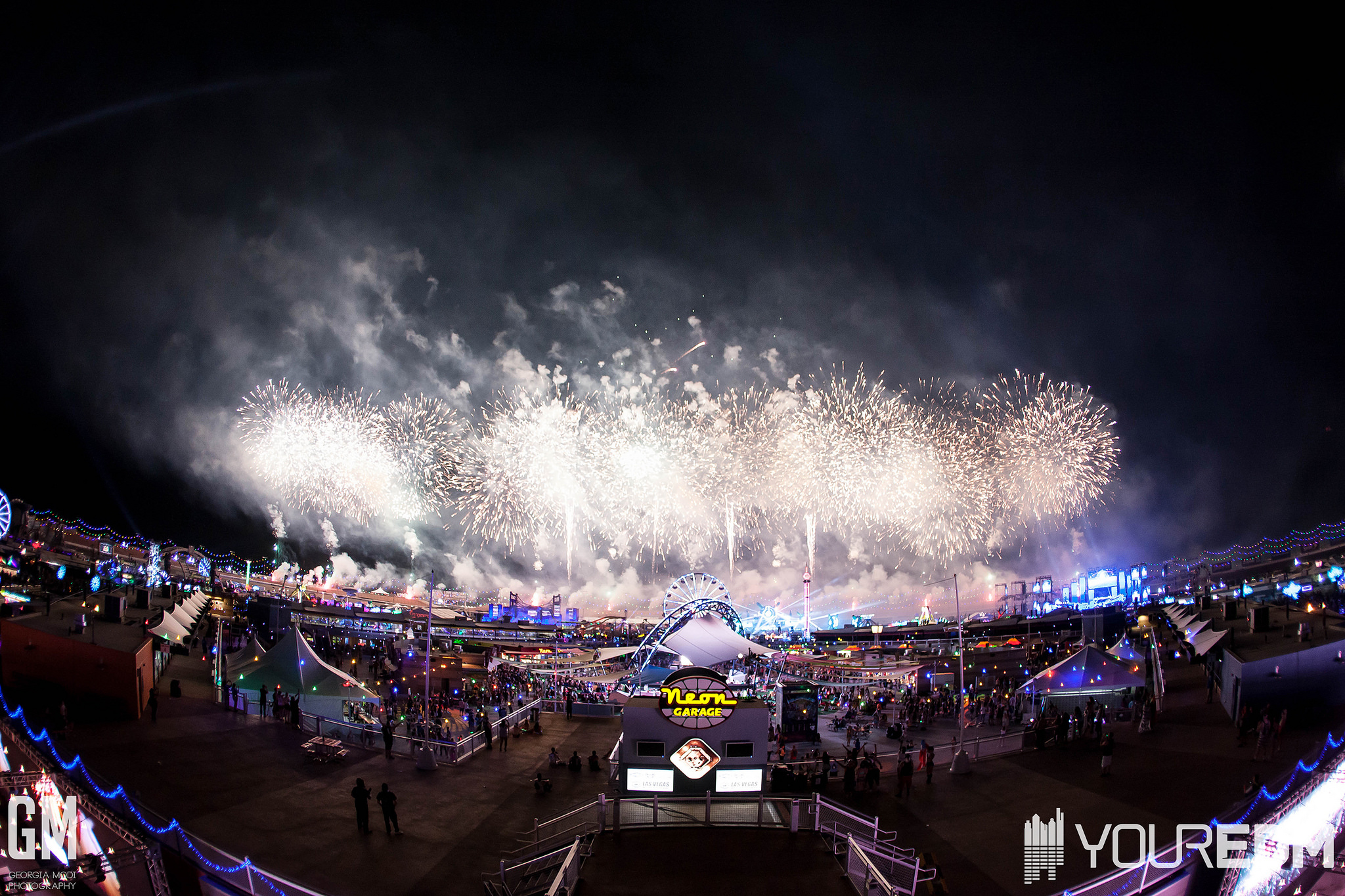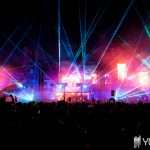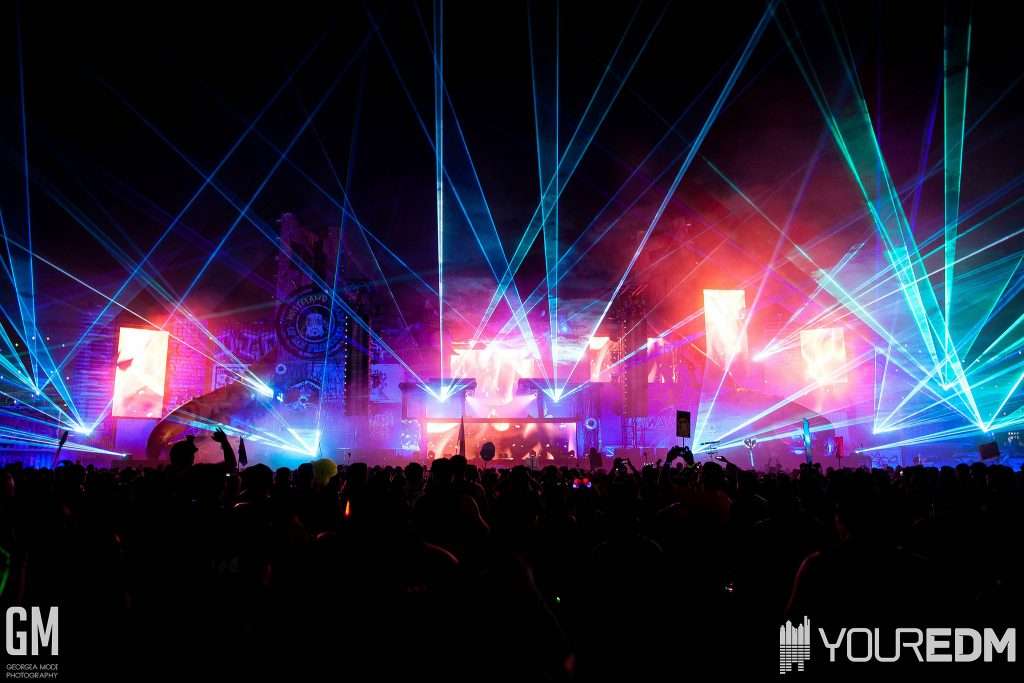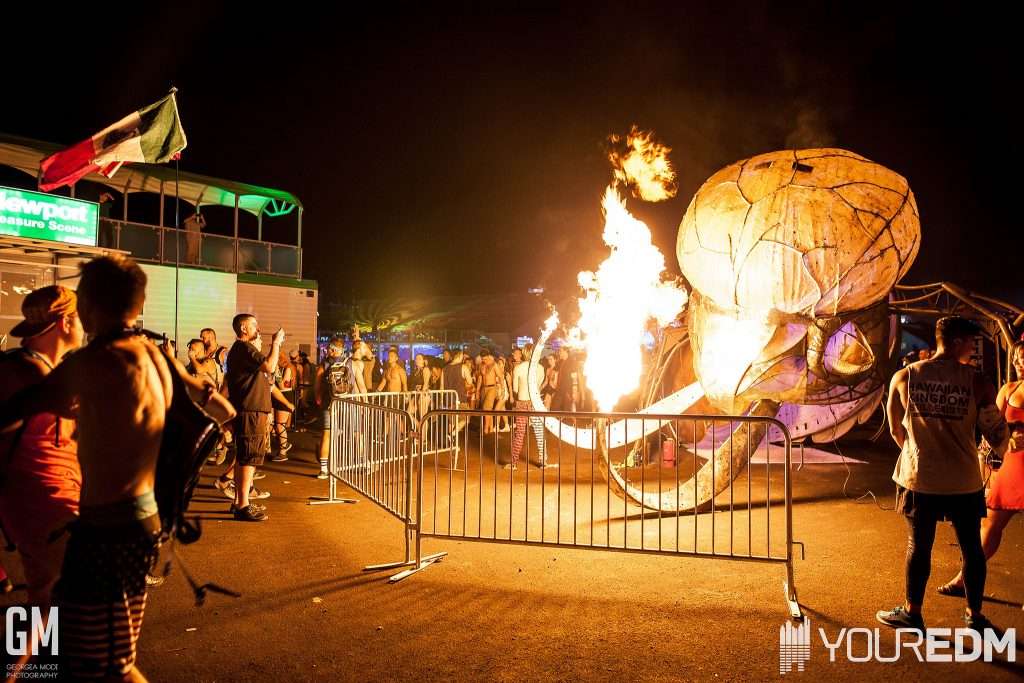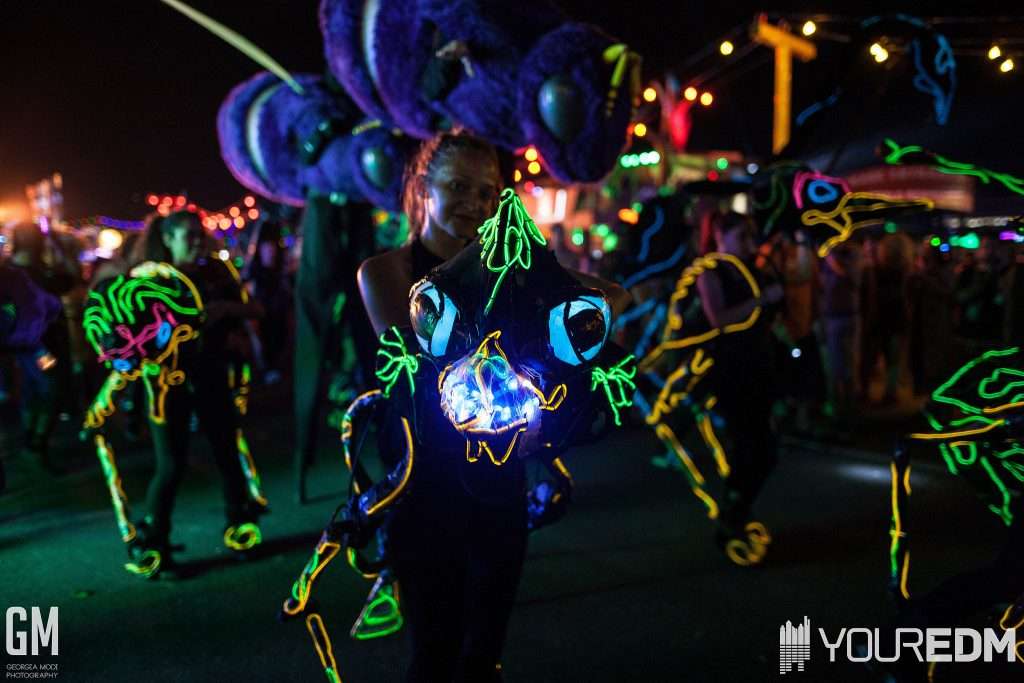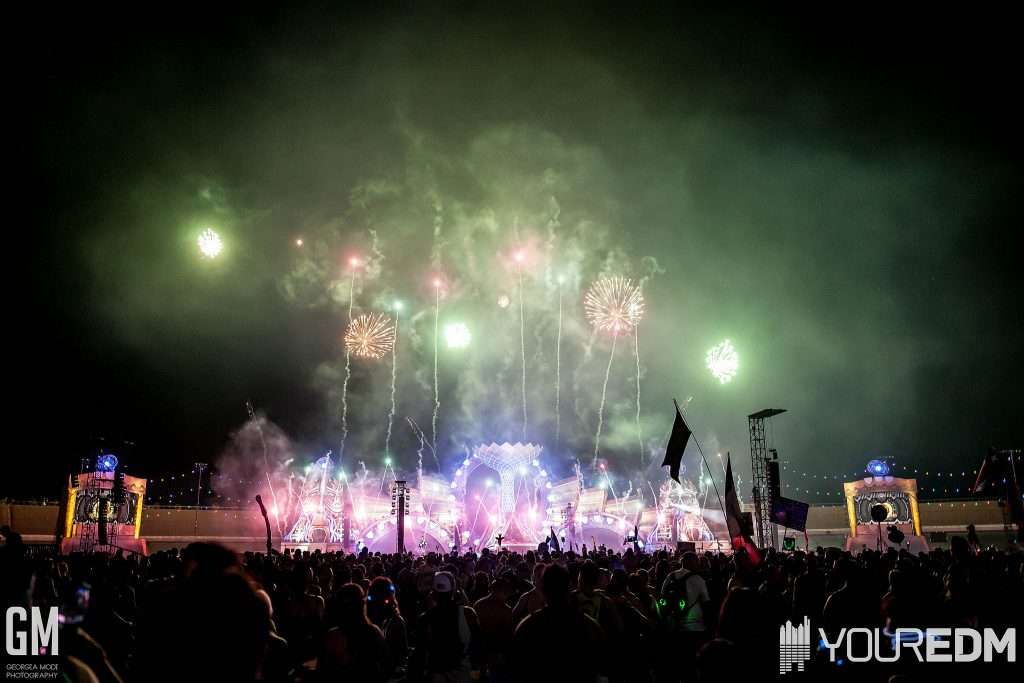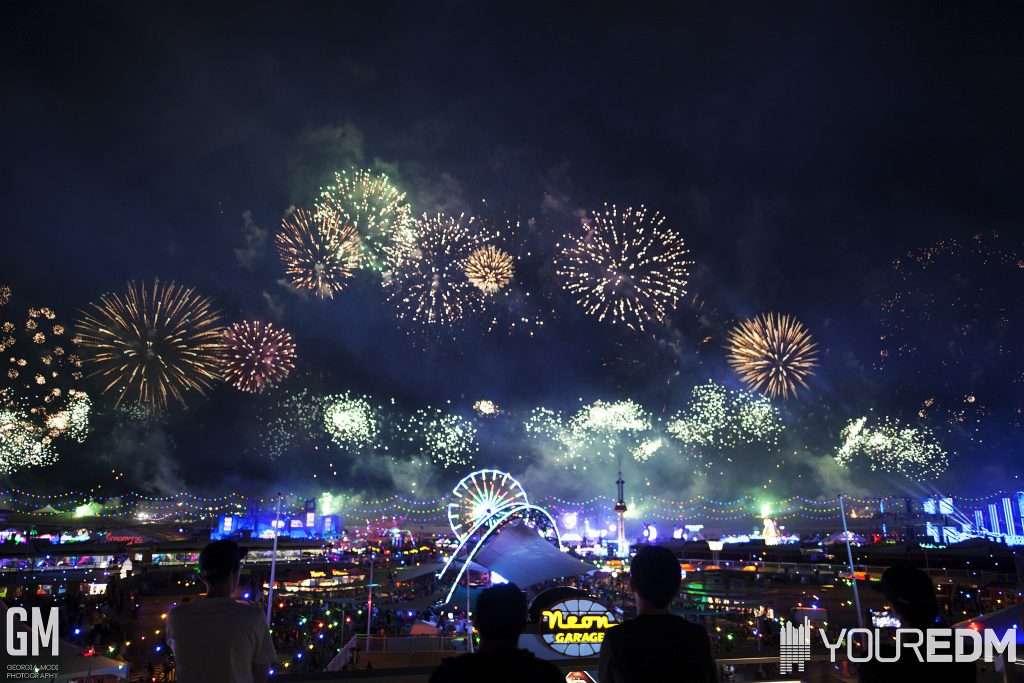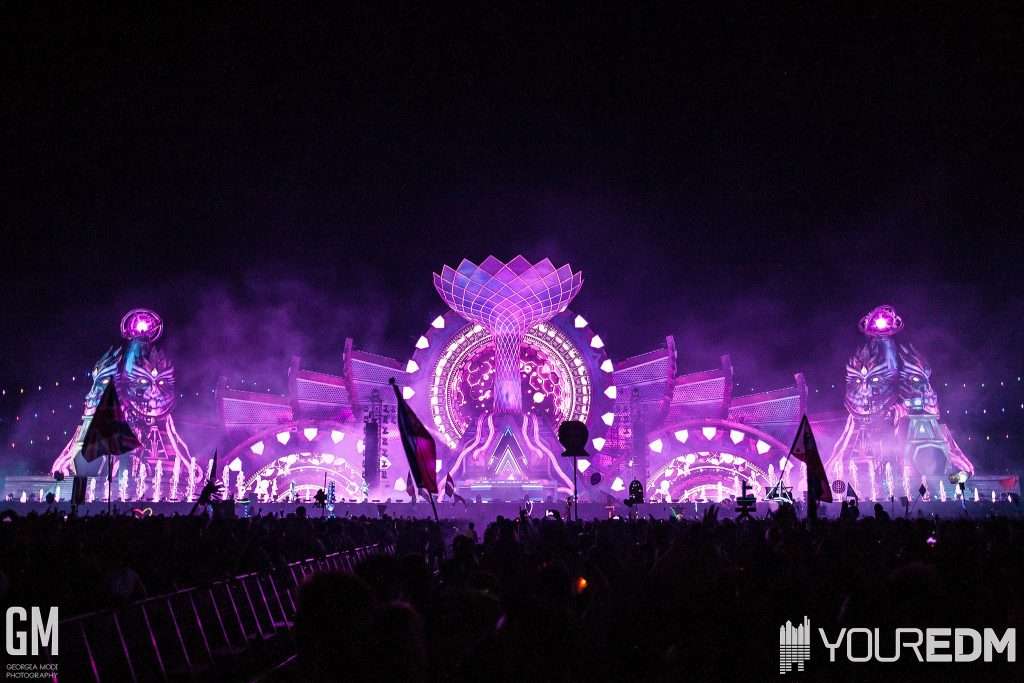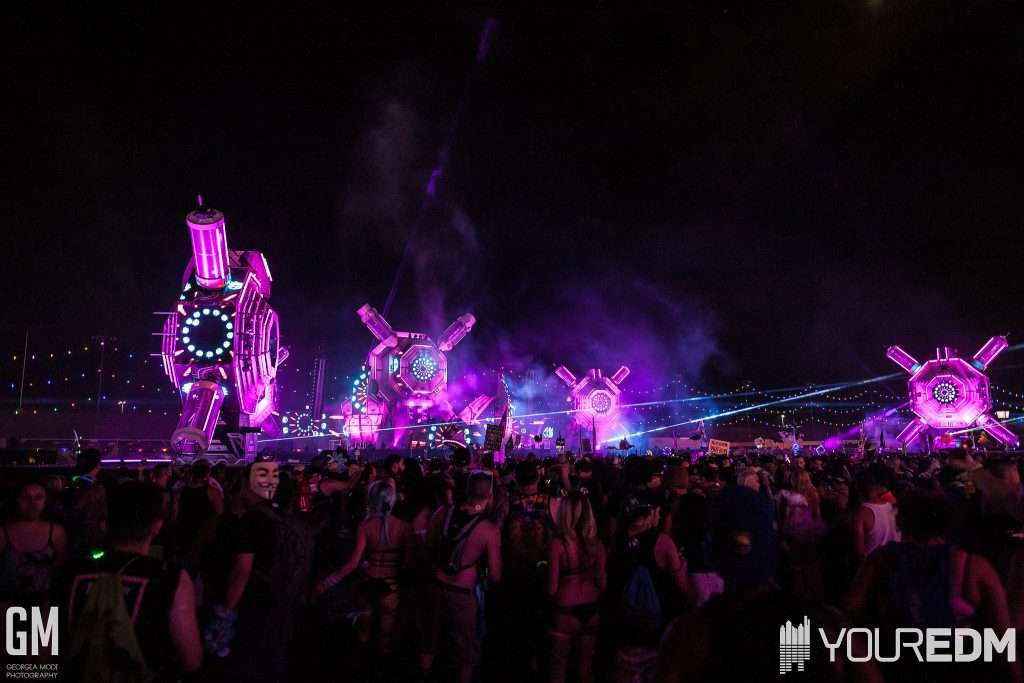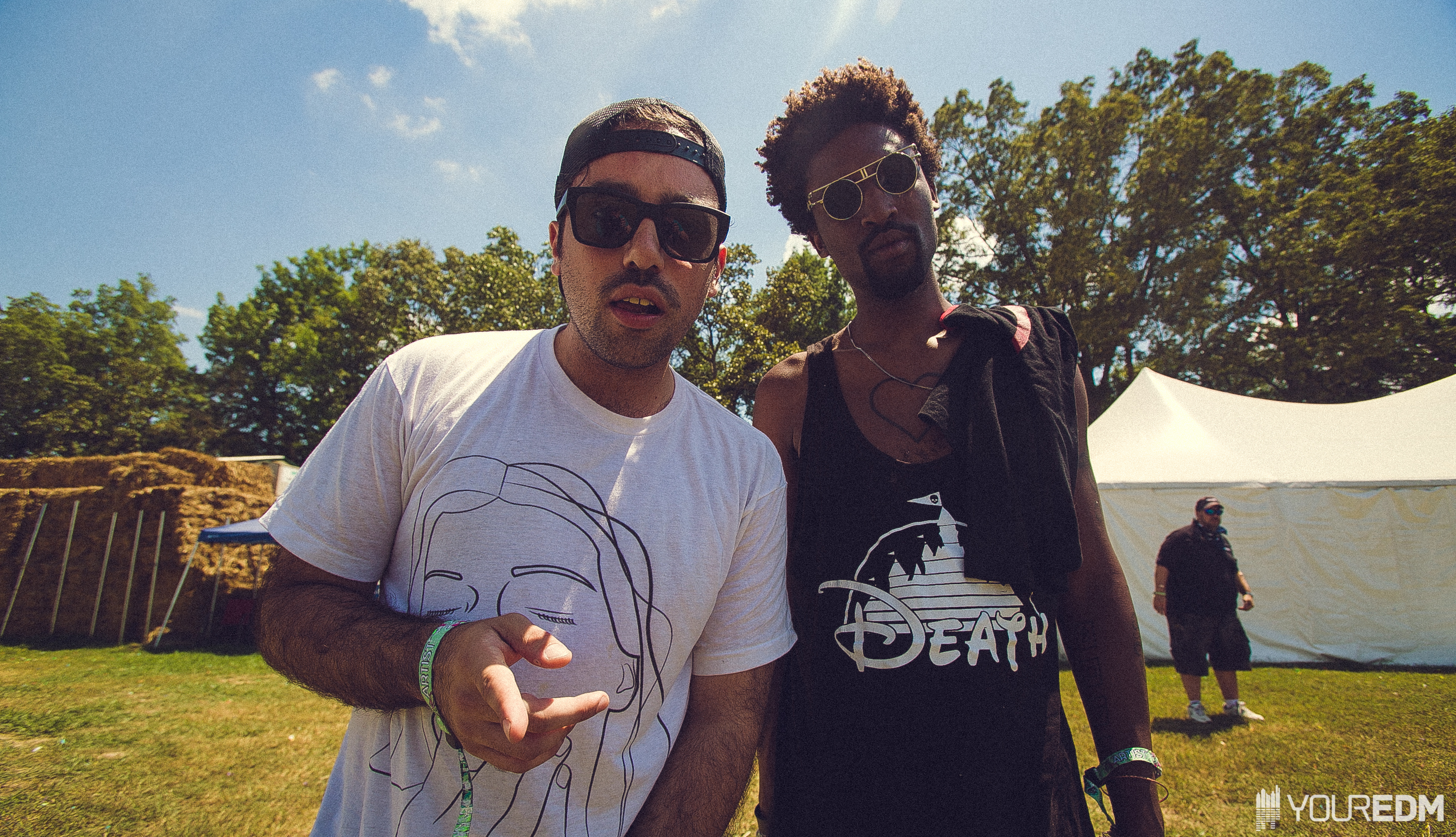The long drive north from the Las Vegas Strip towards the desert on the evening of Friday, June 17 was littered with caravans of painted vehicles, passing billboards with three-story tall photographs of DJs and the slowly approaching Speedway in the distance. Strings of hanging lights stretched around the length of the immense racetrack as attendees proudly donning splashes of color, feathers, flowers, latex and their own bare skin funneled themselves through the various entrances and over the sides into the fray within.
This day marked the beginning of Electric Daisy Carnival‘s 20th anniversary installment, a historic and desperately anticipated gathering of more than 400,000 of electronic dance music’s most dedicated and passionate followers. In an era when traditional rave culture is slowly being extinguished by the major music festival circuit and celebrity DJs, EDC proved itself, against all odds, as a keeper of the flame and one of the last surviving beacons of a community whose past prominence propagated the current scale of the industry as a whole.
Through an intricately planned network of performing acts, stage design, branding and marketing, Insomniac, the Pasquale Rotella-founded company responsible for the event, managed to represent both the unique, intimate communities that define EDM and the powerful, mainstream spectacle expected of the largest electronic music festival in the country.
The first and most important factors in maintaining this delicate balance, however, were the attendees themselves. The types of people that populated the Speedway during the weekend were not reminiscent of a usual festival crowd. Color and individual, personal identity quickly became the defining traits of nearly everyone who entered, with high-flying totems and hand-crafted accessories in heavy circulation. There was a clear and palpable sense that attendees favored self-expression and personal comfort over the now-typical festival tendency of looking cool and chic for events like Coachella. The get-ups were wacky, hilarious and truly different from one another, making the traditional “rave” qualities of acceptance and camaraderie more concrete and believable in their presence.
The location and timeframe of the event were also enormous contributors to the overall feeling, as each night ran from a 7 p.m. sunset to a 6 a.m. sunrise. Under the cover of darkness and night, the wild and otherworldly nature of the festival was able to take hold of those in attendance. Surrounded on all sides by towering walls, the venue forced fans to constantly weave through massive neon structures and past flocks of animalistic performance artists. The Speedway’s isolation from the rest of the city, its all-night runtime and the oversaturated presence of circus-like spectacles and larger than life stage productions inspired visible senses of freedom and uninhibited expression amongst attendees that acted as the embers for the event’s magic and fantasy.
Finally, Insomniac’s own communication with their fans during the evenings completed the picture of a traditional rave environment. Those who made notifications available on their phones for the festival’s mobile app consistently received small words of encouragement, excitement and inspiration. “Remember to stay hydrated!” “Isn’t it beautiful?” “Welcome home.” Each of these small phrases came as a sort of whisper from a higher power, subtly guiding and lifting the crowds towards safety and unity.
The collection of these factors effectively culminated into an experience that acknowledged both the immensity of the proceedings and the intimate, personal moments within them. It was the looming awareness of EDC’s more mainstream reputation, however, that came as a deterrent for some fans, disallowing them from fully embracing the rave-like nature of the event.
With each passing year, EDC’s headlining Las Vegas installment grows larger and more influential both within the dance music community and the outside, public sphere. More than 400,000 attendees populated the sold out event last weekend, packing in to the most expansive series of festival stages, booths and rides in the nation. Especially in the city of Las Vegas, long known for its firm grasp on the most popular and crowd-driven DJs of the era, an event of this caliber was unlikely to go unpublicized in the biggest media outlets in the world.
As the EDM bubble continues to expand and flourish far across the globe, Las Vegas sits at the epicenter of the movement. Its size and scale are the opposite of traditional raves, which have long been known to be held in secret, underground locations only revealed to a few lucky followers of the culture. But during the most important weekend in EDM, and despite being in the most saturated city in the country, Insomniac managed to maintain the innate, backbone feeling behind the most niche dance music events in the community.
Whether the festival came off as too mainstream and overinflated or truly representative of the traditional rave scene was a matter of choice on the behalf of each individual who attended. For those in Las Vegas who decided not to visit the festival, seeing the pictures, reading the numbers and looking at the billboards would likely have framed it as chaotic, overdone and entirely mainstream. They did not have the chance to experience standing among their peers in the center of circuitGROUNDS or walking through the stilt legs of a giant flamingo as it strolled across the cosmicMEADOW. The intimate moments that made up the true EDC experience were lost on those who decided not to engage with the spectacle as intended. The real determinant of a successful festival weekend, and something that Insomniac knowingly prepared for, was the individual’s unique experience at the event. If a real rave was what an attendee wanted, it’s exactly what they received.
My own love for electronic music came about in 2012, after a few friends took me to see Paul van Dyk inside Coachella’s Sahara Tent. Before that time, I’d been an avid follower of indie folk, obscure world music and the jazz and classical pieces that I’d grown up listening to in my dad’s car and performing on the piano. I remember the moment of my conversion so clearly, because of how unique and visceral the feeling was. In the middle of van Dyk’s set, a build began that lasted more than three minutes. By the time it reached its height, the pounding kick drums, squealing rushes of white noise and spectrum-wide slaps of snare were enough to bring me outside of myself. When it finally dropped, the sonic chaos was transformed into a steady and overwhelmingly powerful rhythm. I remember perceiving a distinct sense of humor and self-awareness within the simple melody which, when combined with the immense crowd’s eruption of movement and expression, brought me into an almost spiritual mental state. I had been hooked.
It was after this defining moment that I began to exclusively attend electronic music events and festivals. I went through a brief phase which focused on electro house and moombahton. From there, I sank deeply into the bass music and trap sectors, eventually emerging into the more downtempo, hip hop-inspired genres that define labels like Soulection or HW&W, where I still reside today.
My days of wearing kandi in the traditional sense are long over, despite still attending electronic shows with as much frequency as I did at the start. I’ve felt distant from the more dedicated sectors of community for years, and never would have thought that I would able to witness the same feelings of thrill and magic around me at EDM shows again. This was, of course, before I attended EDC in Las Vegas last weekend.
It was there that I unexpectedly rediscovered the community that had initially carried me into the genre in 2012. This year was my second time at the festival, the first as a member of the press. I arrived in the city by myself, and stayed alone during the weekend despite spending substantial time with my younger brother and other members of the Your EDM staff. For the most part though, I was looking after myself while I wandered the Speedway, unlike the many groups containing upwards of 10 or 15 friends. Because I was never in a group larger than four or five, and even then only briefly, my level of concern and stress when navigating the venue was very minor.
As a dedicated lover of all things bass music, I spent most of my time during the weekend planted firmly at the bassPOD stage watching some of the best dubstep and trap artists throw down their gnarliest sets to an overwhelmingly energetic crowd. Excision‘s monumental performance was a clear standout for me on Saturday evening. I was never brought out of the action for a moment, even when fireworks began exploding right behind him.
The stage productions were some of the most incredible and memorable parts of the experience. Towering structures, screens for miles and pyro on every stage made for a visual sight equally as powerful as the music being played. No matter how much I wanted to lose myself in the lights, sounds and crowd, however, I was on a constant mission throughout the weekend to make sure I was hydrated, somewhat rested and conscious of my health. At any given moment, I was aware of exactly how much water I had in my backpack, where the nearest water station was, and if I was overheating. Being by myself made taking care of these things relatively easy, but it made me worry for the large groups of people that would have had to check in and account for each of their members before trekking to get more water or going to cool off.
There were also several factors that I genuinely hope were acknowledged by Pasquale and the production staff as items to change for 2017. Getting into the venue the first two nights was met with extreme difficulty for me. The organization of the various entrances was confusing, and the security staff on site was often very unwilling to hear my questions before sending me away to the next station as if I had been trying to pull something over on them. After speaking with several members of the security team, I discovered that all they had been told was to stand at their posts and to reference a printed laminate describing which color of wristbands were allowed to enter. If a problem or complication like faulty scanners arose, which it did several times, they had not been given instructions on who to speak to or how to solve the issue. This led to virtual hours spent walking around the edges of the Speedway trying to find the right way in on Friday and Saturday evenings.
Another aspect that was pointed out to me by a member of the media was the complete absence of sniffer dogs and amnesty boxes. Both had previously been present during earlier years of the festival. Whether the idea behind taking them away was to prevent potential substance users from getting frightened and ingesting all they had before entering, or other safety concerns, it came off as odd and perhaps dangerous when considering the amount of drug-related incidents at festivals during the last year.
Despite the incessant heat and severe lack of sleep, however, the experience of being back on the Speedway and witnessing fans from all around the world come back to their most treasured event of the year was a truly worthwhile venture. It made me remember what is was like to fall in love with the genre and community in the first place, even after so many years since my initial introduction. I look forward to 2017 immensely and know that with the proper attention and understanding, Insomniac will create the inclusive, exciting and safe festival atmosphere that their hundreds of thousands of Headliners crave and deserve.
Photo Credit: Georgia Modi Photography
